Please Take Note: This is a review of the game’s final prototype. The art, game bits, and the rules discussed are all subject to change. The game is being reviewed on the components and the rules provided with the understanding that “what you see is not what you might get” when the game is published. If you like what you read and want to learn more, we encourage you to visit the game’s Kickstarter campaign. Now that we have all that disclaimer junk out of the way, on with the review!
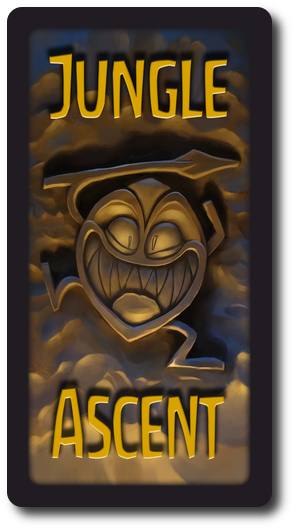
The Basics:
- For ages 8 and up (publisher suggests 10+)
- For 2 to 4 players
- Approximately 40 minutes to complete
Geek Skills:
- Counting & Math
- Logical & Critical Decision Making
- Reading
- Pattern/Color Matching
- Strategy & Tactics
- Risk vs. Reward
- Visuospatial Skills
- Hand/Resource Management
Learning Curve:
- Child – Easy
- Adult – Easy
Theme & Narrative:
- Atop a great cliff lies a treasure beyond imagination and slightly out of reach
Endorsements:
- Gamer Geek approved!
- Parent Geek approved!
- Child Geek approved!
Overview
It is said a mighty and long-lost civilization of great wealth and power took all their treasure and knowledge and put it on a very high shelf where no other civilization could reach it. And there is stayed while all the smaller and less advanced civilizations looked up and wanted it much like a 3-year-old wants a cookie. Centuries later, brave explorers have found the proverbial shelf on which the treasure was placed. It was located on the very top of the Cliff of Frab, which was located in the deepest part of the most remote jungle of the world. Now, standing below the cliff, a team of explorers looks up and begins to ascend its dizzying heights. In their hearts they know that only one can claim the treasure, and so, they race to the top and let nothing stand in their way!
Jungle Ascent, by 5th Street Games, is comprised of 1 game board that represents the cliff face the players are attempting to scale, 4 Explorer pawns (in 4 different colors), 4 Ownership tokens (in 4 different colors that match the Explorer pawns), 43 Pathway cards, 17 Hazard cards, and 28 Effect and Interrupt cards for a total of 88 cards. As this is a review of a prepublished prototype, we will not comment on the component quality. The art direction and proposed final illustrations, however, is simply fantastic. The artwork on the prototype game pieces was also superb and made it very easy to play the game, even if it was just on paper and put together with tape.
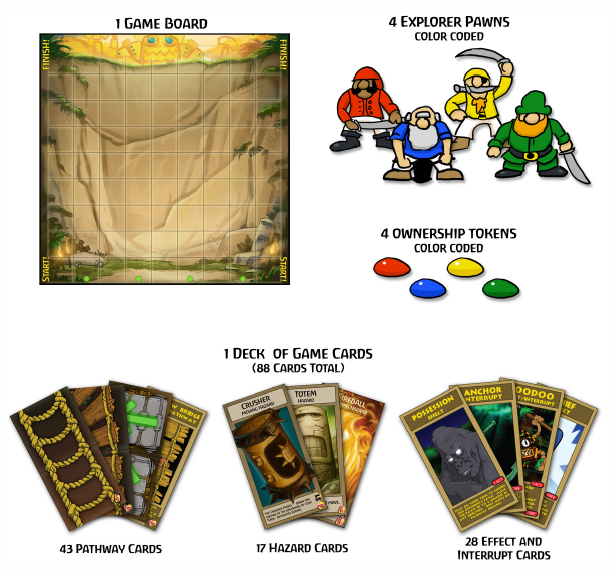
Welcome to the Jungle
Note: the following is based on the 5th version of the game rules, which are subject to change prior to the game’s final release.
To set up the game, first place the game board in the middle of the playing area and within easy reach of all the players.
Second, have each player select an Explorer pawn and the Ownership token that matches the pawn’s color. The Explorer pawns should now be placed on the game board on the bottom row. On the bottom row are green dots. These indicate the starting positions on the bottom row for any Explorer pawn.
Third, shuffle the entire deck of cards and deal out to each player 5, face-down. This is the player’s starting hand and they should keep them hidden from other players at all times.
Fourth, Place the remaining deck of cards to one side of the game board. This is now referred to as the pile. The space next to the pile is the pit, which is used for discarding cards.
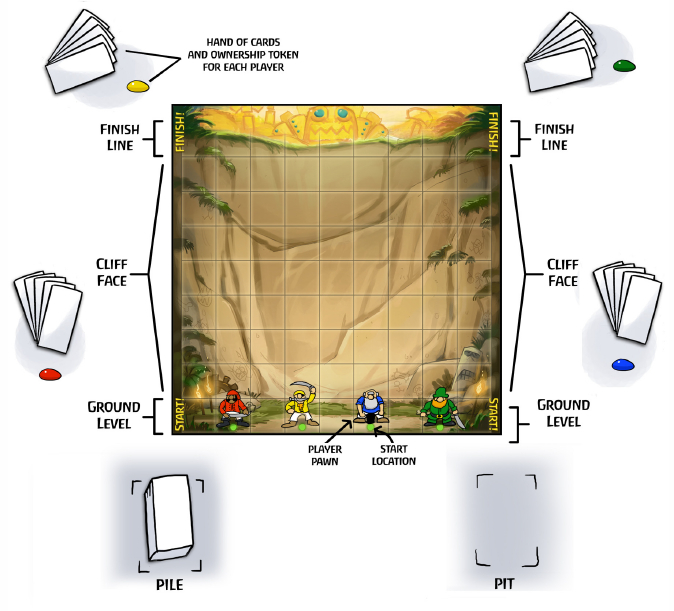
You are now ready to play! Select the first player and get climbing!
We’ve Got Fun and Games
The game is played in rounds with each player taking a turn that consists of two actions. Once the player is done taking their two actions (or one action that costs them the equivalent of two actions), the next player going clockwise has their turn. This continues until the game’s endgame condition is met.
On a player’s turn, they will complete the following steps in sequential order:
Step 1: Move Hazards
If the player has any Hazard cards in play, the player now activates them, moving them as required and directed by the card. Note that moving a Hazard will take an action to complete. This also includes detonating any bombs and removing any fungal growth caused by other cards.
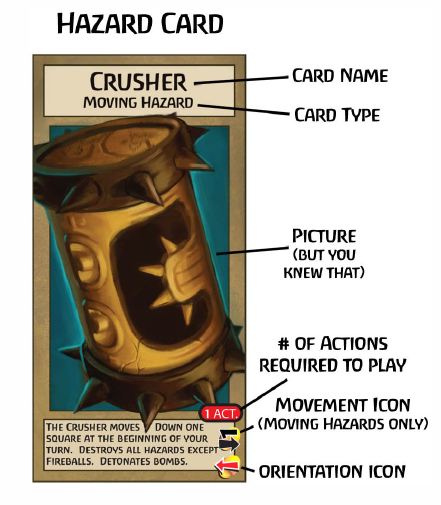
Step 2: Use Actions
The player can now take up to two actions or take one action using a card that costs to actions to play (that is, if they have not moved any hazards in the previous step). The cost to play cards is noted on the card itself. By default, the player can take the following actions with any card text and descriptions taking precedence and trumping any other written rule.
- Play a card (for 1 or 2 actions – if for 2 actions, it must be played first…obviously)
- Move Explorer pawn one square in any orthogonal direction (i.e. not diagonally)
- Draw 2 cards from the pile
Player movement requires a bit of explanation as it can be confusing for little geeks and non-gamers. As already stated, a player’s Explorer pawn can only move orthogonally. Additionally, they can only ascend and traverse the cliff face by using ladders, walkways, and conveyor belts that are represented by the Pathway cards, and never ever touch a Hazard card. These cards are played directly to the game board and only if the Pathway card does not overlap another card, not played on the bottom row, and can fit on the board (i.e. fit in the game board grid squares). To help the player, cards that are played to the game board have an orientation arrow icon that indicates which direction to place the card. Pathway cards can be placed wherever the player likes (given the limitations already stated) and need not be connected to another Pathway card. In fact, as the game progresses, players will find themselves cutoff from other pathways thanks to hazards burning and blowing things up.
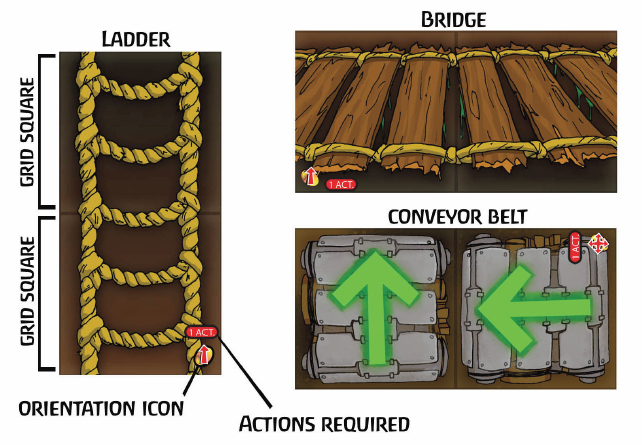
If a player lands on a conveyor belt, their Explorer pawn is immediately moved in the direction indicated by the arrow as soon as it lands on it, but only once. If the pawn is dropped onto or moved to another conveyor belt, it immediately moves in the direction the arrow indicates, but only once. While a conveyor belt will never push a pawn off the game board, it can drop them and push the player’s Explorer pawn to the very bottom of the cliff (where they land using cat-like reflexes and are remarkably unhurt). If a pawn is ever placed on a conveyor belt that will technically move the pawn forever, the player can opt to simply stop the conveyor belt on a specific space and then move their pawn accordingly for one action. In the very likely event that an Explorer pawn is pushed, moved, or thrown off a Pathway card, it falls straight down and lands either on the next Pathway card or the bottom of the cliff – whichever comes first.
Playing Hazard cards is done exactly like playing Pathway cards except the cards cannot be placed in a way that automatically burns or crushes an Explorer pawn, overlaps a Pathway card space that an Explorer pawn is currently occupying, or another Hazard card. Once played, the player places their Ownership token on it to indicate they are the only ones who can move it. If the player has another Hazard already it in play, it is removed and replaced with the new one. Hazard cards will either burn, crush, explode, hinder movement, or chase Explorers depending on what hazard the card represents.
Effect and Interrupt cards are played at specific times (as indicated by the text description on the card). These cards will hinder other opponents and give the player some temporarily advantages. Some of the Effect cards require the player to spend an action to use them, in which case, they cannot be played until the player’s turn. Interrupts never take actions but can only be played when specified. Once played, these cards are discarded to the pit.
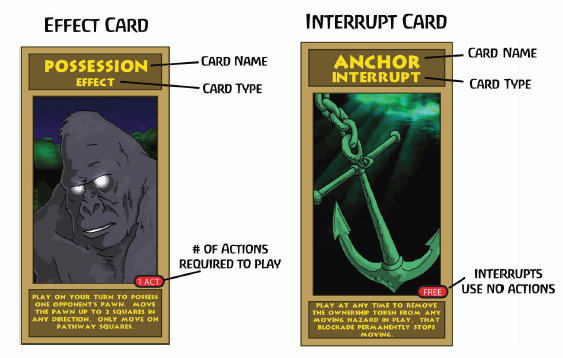
Step 3: Discard Extra Cards
Once the player has completed their turn, they must discard cards from their hand to the pit until they have no more than 7 cards in total.
We Got Everything You Want, Honey
The game immediately ends as soon as the first player ascends to the very top of the cliff and claims the treasure all to themselves. In game terms, this means the pawn ends their movement on the pathway square located on the top row of the game board.
To learn more about Jungle Ascent, visit the game’s Kickstarter campaign or go to Board Game Geek and download the current rules (that are subject to change prior to final publication).
Prediction
Now here is a game that made me smile as soon as I read about it. The “old school” video gamer in me started jumping up and down as memories of many long and expensive afternoons spent at the arcade playing classic 8-bit gems like Donkey Kong and Q*bert came flooding back to me. Gads, the amount of money I spent on those games makes me pale when I start doing the math. Thank goodness for home console systems! Much more cost-effective, but just as big (if not more so) a time sucker.
The game does not sound difficult after reading the rules and the simple orientation of the cards on the square grid will make it easy to teach and to demonstrate. The only possible issue I see is with the little geeks who want to play and the heavy amount of reading that is necessary to play the game competitively. A player must be able to read the text on their cards and understand not only what they do, but how to go about it. For my 5-year-old (and any gamer who is still learning how to read), I don’t believe this game is for them. I’m sure they’ll want to play, however, and I don’t see any issue that would hinder game play or game balance if the younger little geeks were to team up with an older geek. If nothing else, they can move the cards and pawns on the board. That right there is already half the fun.
As expected, teaching the game didn’t take long. For veteran players, the cards and their timing were very easy to understand. For the non-gamers, Child Geeks, and Parent Geeks who were not as familiar with games that used cards with special timing requirements, it took a bit longer. My 8-year-old, who plays Pokémon, had no issues whatsoever and helped teach the game to adults. After only a few demonstrations, everyone we played the game with felt confident that they understood the rules and were ready to play after only a few minutes of game explanation. And so, as I set up the game for my first family play, I asked my little geeks their thoughts on the game so far.
“Cool game! I really like how you can create traps and drop things on players!” ~ Liam (age 8)
“I’m on Liam’s team, Daddy!” ~Nyhus (age 5)
Excellent. The little geeks are pumped and ready to go. Let’s see if this game is worth playing or if should be left on a very high and forgotten shelf to collect dust.
Final Word
Oh, how the little geeks loved and hated this game! To be specific, they loved the game play and had a wonderful time playing it, wanting to play again as soon as the game was over. What they hated was their father and the many hazards he sent. This, however, proved to be a boon for the little geeks because using hazards takes actions and using actions to move hazards means there is less actions to move Explorer pawns. The little geeks got really good at dodging and ducking, playing Interrupt and Effect cards like champs resulting in outwitting their father’s various traps, tricks, and trips. I could not be more pleased, and nor could they. Both the little geeks gave the game high marks and greatly look forward to playing it again. And yes, as expected, my 5-year-old could not play the game by himself, but did an outstanding job as a team member. My 8-year-old had no problem playing the game, which makes us believe the suggested minimum age for this game can be reduced to 8 versus the publisher’s suggested minimum age. In the end, of course, it all depends on the little geek and their current level of mastery of the geek skills.
Parent Geeks also had a wonderful time with the game, with and without the Child Geeks present. The game is casual and allows for much table talk and banter. The game rules even suggest that players should participate and fully engage each other in “cajoling, wheedling, badgering, bartering, and exclaiming”. This the Parent Geeks did, and when there weren’t any Child Geeks within earshot, the wordage became very colorful. Non-gamers also had a great time with the game, but were slightly more frustrated with the Interrupt and Effect card game play.
Gamer Geeks had a blast with this game and were absolute jerks to each other, which turned out to be the most fun part of the game. Their level of enjoyment increased as the game plays became more aggressive and everyone had a great time with the hazards. When the game was over, the Gamer Geeks just sat back, smiled, and asked “want to play again?”
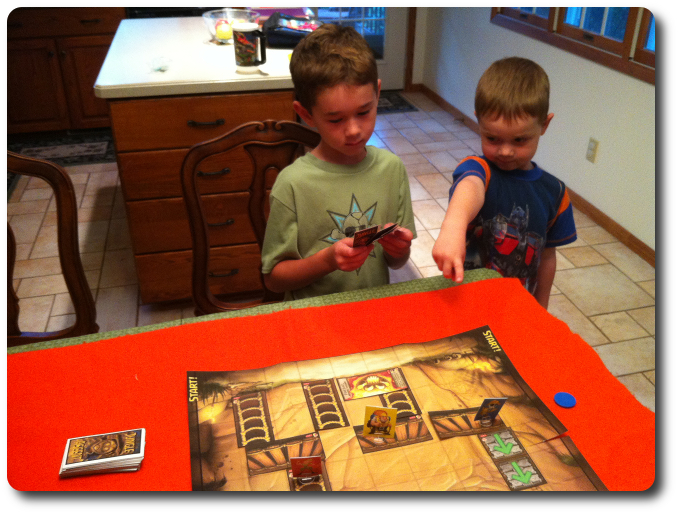
As my two little geeks strategize their next move, I grin evilly as I plot my next hazard OF DOOOOOOM!
Gamer Geeks, this is a casual game of timing and positioning. You’ll enjoy the light strategic and tactical elements provided with the use of the cards, and the way the pathways are built. The ability to switch from offensive to defensive (and vice versa) in a single turn is also a great deal of fun and allows for some very interesting plays. Several times, players baited others by putting pathways in front of them that only lead to making them a big target for hazards. Other times, Pathway cards were played to purposely block other players, making the hazards useful as game board cleanup tools. The entire game is tight, solid, and fun. This game will be an excellent start to your game evening, but might be considered by some to be an excellent filler, as well. Regardless of when you play it, you’ll enjoy it.
Parent Geeks, this is a great game for family and friends to play together at the table. It is very casual and allows for distractions without impeding the game’s progress or the player’s ability to participate. Non-gamers will have no problem learning this game and the game plays very well with different age and experience groups. The only issue you might find annoying is the number of players, which currently only allows for a maximum of four. You’ll quickly find that more than four players will want to play this game at any particular time, which means that some players will have to be left out. But the game plays quickly and any individual waiting on the sideline won’t have to wait long.
Child Geeks, this is a game that will test your ability to think ahead and position yourself where there is the least amount of risk. Even if you do fall, however, don’t worry about it. Your Explorer is impervious to damage and is just as determined to reach the top of the cliff as you are. You’ll enjoy the many different ways you can make your way to the top and the many different options to send your opponents to the bottom. This is a game of reaction as much as it is action. Use those Interrupt cards wisely to fend off other players and never hesitate to use those Effect cards to get yourself a quick boost. But do keep in mind that you only have so many actions and so many cards. Resource management is a must least you find your Explorer pawn directly under a crushing hazard with no way to go but straight down.
I really enjoyed this game and found something new to smile about each time I played it. Usually, by the time I am done testing a game with our groups, I have explored just about every corner possible or know where to look. This game kept me guessing as I found new ways to use Pathway cards to benefit myself and hinder my opponents, better and smarter ways to use Hazard cards, and the importance of timing with the Interrupt and Effect cards. I also enjoyed the light but very important use of resource management the game requires. Each player only has so many actions and the use of Hazards can be costly. This made playing the Hazard cards something the player had to think about and kept the game board free and clear of clutter. Put another way, the game did not suffer from needless hurdles and each trap or pitfall that was on the board was well thought-out and used wisely. Additionally, the amount of player interaction via the game board and the cards made the game very social. In the end, I could not ask for more from this game except, perhaps, more time to play it.
If you are looking for a light and casual game that requires strategy, tactics, timing, and encourages much smack talk, then do get your hands on Jungle Ascent. We think you, your family, and anyone else lucky enough to play this game with you will be most pleased.
Oh, and extra credit for you if you started humming Guns and Roses while reading this review.
This game was given to Father Geek as a review copy. Father Geek was not paid, bribed, wined, dined, or threatened in vain hopes of influencing this review. Such is the statuesque and legendary integrity of Father Geek.



